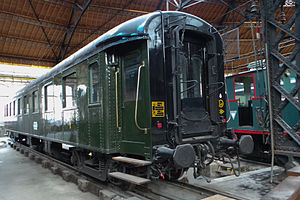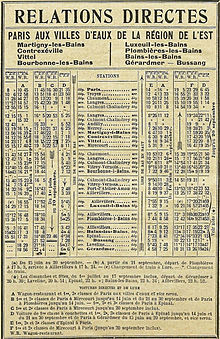Train d'eaux
| Train d'eaux | |
|---|---|
| Train type: | Express train |
| Countries: |
|
| First drive: | June 2, 1893 |
| Last drive: | September 1, 2002 |
| Former operator: | EST , SNCF |
| route | |
| Departure station: | Paris Est |
| Destination station: | u. a. Épinal, Strasbourg |
| Technical specifications | |
| Gauge (s) : | 1435 mm |
Train d'eaux (also: Train des Eaux ) was an express train and the brand name of French coaches trains, as baths trains in passenger transport between Paris and the de gamme skin -Thermalbadeorten in the western Vosges were used. The train connection, which attracts affluent bathers, was given special attention by the railway companies because the transport there promised high profitability, as poster collections from the early years show. First used in 1893 by the Chemin de fer de l'Est (French Eastern Railway), it ran three times a week in the summer months until 2002, with the war interrupted. She drove back the following day. A special feature is that until the third car class was abolished in 1956, only first and second class cars were used, at times also Pullman cars . The ten baths in Bains-les-Bains , Bourbonne-les-Bains , Contrexéville , Épinal , Gérardmer , Laveline-devant-Bruyères , Luxeuil-les-Bains , Martigny-les-Bains , Plombières-les-Bains and Vittel were given different Through car connections served.
After the First World War , a train connection from Clermont-Ferrand and Strasbourg was added. The Culmont-Chalindrey station in the Haute-Saône department, which is far too large in relation to the town, was the most important traffic hub with its five platform tracks. This train connection was supplemented by further train runs, so that four to five connections were offered daily to all destinations, but these then with a change to other trains, but in all car classes .
After an interruption in the Second World War , the train to and from Paris ran again from the summer of 1946. It was numbered 405/406, the VE- / EV-Express came from Clermont-Ferrand and the 407/408 from Strasbourg . While the first two trains were split up into their different, coach-specific units in Culmont-Chalindrey in the early afternoon - another split took place at Aillevillers station and in Épinal - the train from Strasbourg drove early in the morning to Vittel, which it was against Reached noon.
In Paris, the train started with thirteen cars plus dining cars, four of which were handed over to the train from Clermont-Ferrand and three of which he himself took. In the railway station Aillevillers remained six cars, three of which were led on to Plombières-les-Bains, the other six went as train 406 together to Epinal , where the train was again halved. Three wagons went to Gérardmer , three continued to Strasbourg .
The VE from Clermont-Ferrand had eight cars plus dining car to Culmont-Chalindrey, and nine to Mirecourt station, five of which were decoupled there and two continued to Strasbourg. Three of them, supplemented by a new car, drove on to Metz station .
Over the decades the rolling stock changed. Only four-axle were basically used passenger train - through cars .
The line to Luxeuil-les-Bains was not opened at all after the war due to war damage.
literature
- Maryse Angelier: Thermalisme et rail, sources de progrès . In: La vie du rail , 1911 edition, September 29, 1983, pp. 46-50
Individual evidence
- ↑ a b c l'Histoire du Train des eaux , 2011 (French)
- ↑ La ligne 4 in: Ferrovissime No. 91 Janvier / Février 2018, p. 22.
- ↑ a b c l'Histoire du Train des eaux , 2011 (French)

